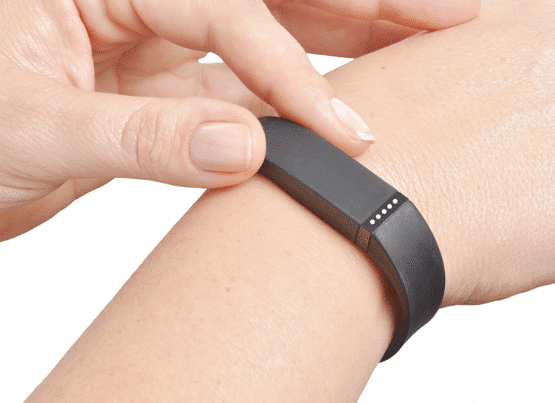Oh great. Here comes another article on how there is one more thing that is making you fat and sick. Bear with me for just a second. I think you are going to like what I have to say. I know you like your fit bit and I don’t want you to throw it away. I just want you to look at it differently. Your FitBit isn’t actually making you fat, it’s how we are using it that is causing the problem.
The goal of the FitBit (or similar devices) is to get you to move, and I am all for motion. Motion is life. We live in a society that is sitting, and it’s just getting worse so we need every little thing to help us move. When we stop moving our body reacts in a certain way. As soon as one sits down, electrical activity shuts off in the leg muscles. Calorie burning is significantly reduced (potentially to as little as one calorie or less, depending on one’s height, weight, gender, etc.) and lipase, an enzyme in the legs that assists with the breakdown of fat, dramatically and rapidly drops. After two hours of sitting, HDL (the so-called good cholesterol) levels drop by 20 percent. After 24 hours of sitting, insulin effectiveness drops 24 percent and the risk for diabetes rises. Sitting increases the risk of death up to 40 percent. So if your FitBit inspires you to move then go for it.
The problem is now people are just counting calories in and calories out. We are not worried about FIT VS FAT. We live in an era of fitness where we know that how we train our body can predict health outcomes. Our focus has changed from just looking good and weight loss to a more fitness oriented focus. Fitness is the biggest predictor of health rather than just how thin we look. Ask yourself this question. Can skinny people get cancer or have a heart attack? The answer is YES.
Time Magazine had an article that illustrated that your fitness level dictated your mortality rate more than your BMI. The men who maintained their fitness levels between the two measurements lowered their risk of dying from heart-related or any other causes by up to 30%, compared with those who lost fitness. Those who actually improved their fitness lowered their risk even more, by up to 44%.
So doesn’t your FitBit help you become fit, and isn’t that the goal? Well, yes and no. If all you are doing with the FitBit is to track your steps, or how you perform when you workout moderately, then you are not going to create fitness or lose the weight you want. The reason for this is because of the energy system that is used by your body when you exercise at a low to moderate continuous pace. Continuous exercise can have some benefits, but it isn’t the most efficient and effective way to exercise. You will lose weight, but if you are a pear shaped, then expect to be just a smaller pear. Continuous exercise is based solely around the “FAT BURNING ZONE” theory. FYI, it is a myth. People are always promoting the fat burning zone workouts where you keep your heart rate between 55 and 65% and you will magically burn more fat. Why work harder when you can take it easy and burn more fat, right? Who here wants to work harder?
I call this the Friend Zone of dating/working out. It might make you feel good, but your not going anywhere in the relationship, but you sure do spend a lot of time doing dumb stuff.
During exercise your body either uses sugar or fat for fuel. Fat burning zone was conceived because at lower exercise levels more fat is being burned.
50% of max heart rate=60% fat to 40% sugar (glycogen)
75% of max heart rate = 35fat:65%sugar
So why wouldn’t you want this? Because it is about calories burned.
-You burn more calories when you work out intensly.
-No Afterburn effect from Fat Burning Zone
-Higher intensity exercise done in HIIT (High Intensity Interval Training) create a metabolic disturbance that burns calories after the workout. Known as afterburn.
In a study by Dr. Christopher Scott and the University of Southern Maine, the total calorie burn of low intensity exercise vs. high intensity exercise was examined. A low intensity exercise group cycled at a steady rate of 3.5 minutes. The higher intensity exercise group required three 15 second sprints as fast as the subjects could run.
-cycling group = burned 29 calories
-sprinting group = 4 calories
Total w/ AFTERBURN
-Cycling group = 39 calories
-Sprinting Group = 65 calories (95% of calorie burn occurred after the exercise) (because you are burning sugar during the exercise)
It should also be noted that the cycling group did the exercise 5x longer.
High intensity interval training is the recommended way to increase muscle, burn more fat, improves your ability to perform activities of daily living, improve bone density, increases your VO2 max (meaning your body is utilizing more oxygen to the tissues), and it is more efficient. Your FitBit is only getting a small picture of your motion and if you use it to only do light to moderate exercise then you are not going to get fit. You will ultimately get fat if you don’t have great nutrition. If you do the HIIT and get the AFTERBURN, then you are working out properly. You will not see the calories burned on your FitBit. If all you are focused on is the continuous exercise, then you will experience the negative side effects of that type of exercise which includes an increase in the stress hormone cortisol, increase in appetite, and promotion of fat storage.


